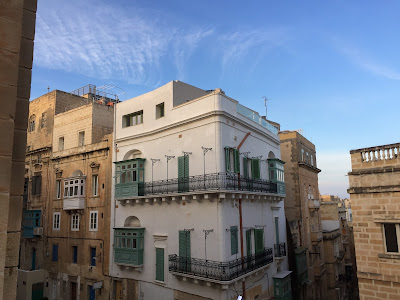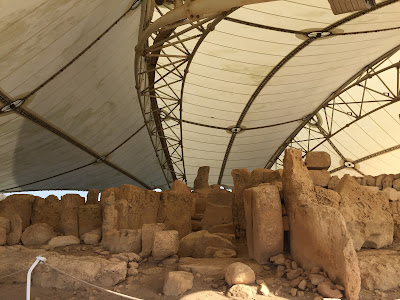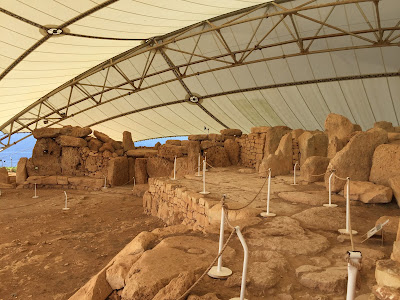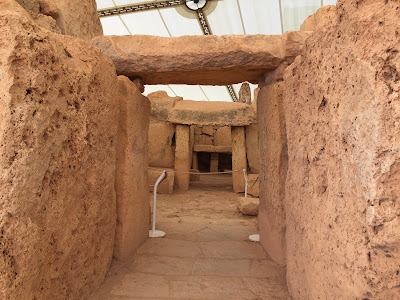



Upper left: View of La Valletta from the Grand Harbor. Upper right: Saint Paul's Shipwreck church. Lower left: View across the Grand Harbor of the Three Cities from La Valletta. Lower Right: St. Lucia's Street in La Valletta.
Overview
If you had asked me what came to mind when I heard the word Malta, I would have responded the 1941 film The Maltese Falcon. Lame, but true. But after a recent visit there for six days, I know a lot more about this fascinating young (it gained independence in 1964), yet old (megalithic structures older than the Great Pyramid) country that sits in the Mediterranean ocean. More precisely, the three principal islands of Malta (Gozo, Comino, and Malta) are 80 km south of Sicily.
Malta has seen a lot: it was ruled successively by the Phoenicians, Greeks, Carthaginians, Romans, Byzantines, Arabs and the Knights of Malta. So as you can imagine, there is a lot of rich history there. And yes, there is a story about the falcon and the island. More on that below in the Nature section.
To clarify, here we talk about our six winter days in Malta, which means there is no information about beaches or other summer activities. We focused on cities, archaeological sites, and museums.
At 1,318 people/km2, Malta is the 8th most dense country in the world. You might think that civility and cleanliness would suffer at such a density, but we did not find that to be the case. (The world average density is 55 people/km2.) That Malta is dense is particularly noticeable when, from the vantage point of the old capital, Mdina, you look across the island and see green, but never without buildings and settlements. Yet with all the density, we found that areas we visited (admittedly, tourist areas) to be very clean. The folks we encountered working at archaeological sites and museums were knowledgeable and helpful. In particular, I remember a woman working in the bookstore of the UNESCO site Ġgantija Temples (it-Tempji tal-Ġgantija). In 20 minutes, she taught us more about prehistoric cultures in Malta than any guide could, and we didn’t even buy a souvenir.
With its red public telephone booths, driving on the left side of the road, and English as one of its official languages, Malta is unmistakably British. Yet, in our opinion, it’s much less British than Gibraltar. Malta is part of the European Union, and uses the Euro, and not the British Pound. And keeping on the subject of the European Union, our trip was made possible by a low-cost Irish-based RyanAir with its direct flight from Bergamo to Malta.
Lodging
We stayed at Lloyd House in La Valletta, which proved to be perfect for us. Lloyd House is a couple of apartments near the Upper Barrakka Gardens, which turns out is a very convenient location. We were started with some basic provisions for breakfast for a few days.
Architecturally, La Valletta is easy on the eyes with its soft limestone tones and colored wooden balconies. As far as cities go it’s young: it took shape in the late 1500s, built by the Knights Hospitaller (Knights of Malta). The foundation stone was laid in 1566 by the city’s namesake Grand Master de Valette. (I have not found any answer as to why the city has two L’s rather than just one.) In fact, if you are planning a visit to Malta, it would be good idea to read up on the Knights of Malta because their history is intimately intertwined with that of the island.
La Valletta, the capital city of Malta, is a laid-back place. It’s set on a grid and rather easy to get around, but it’s also hilly in some parts. On hilly streets, instead of sidewalks, you’ll often find long runs of stairs composed of steps of maddeningly short-height. We learned in a tour (at the Malta Experience) that the short step height was due to the Knights of Malta. When a knight was fully dressed in armor, short-height steps were a godsend. Or, so the story goes.
We ventured out a few days by bus from La Valletta and one of those days we took the Number 41 bus between La Valletta and the Cirkewwa Ferry Terminal (where you can catch a ferry to Gozo). Along the way saw a good part of the northern coast, including Buġibba, a popular tourist resort. From that look, we were absolutely glad we did not stay there. La Valletta has a well-worn charm about it that is a relief to come back to after a day of exploring, not to mention a good choice of restaurants.





Left: St. Paul's Church Mdina. Center left: Ricotta filled pastry at Caffe Cordina, La Valletta. Middle: Pastizzi at Crystal Palace in Mdina. Center right: Lloyd House La Valletta. Right: Statue in Domus Romana in Mdina.
What worked
Touring in winter. There was no swimming on this trip, nor did we see anybody in the water. However, we had great weather, up to 20 C some days, short-sleeve shirt weather for us northerners. At night, it could get chilly, but never below zero. And, we had one day of rain. The best part of touring in winter: low season and less tourists but still fairly good weather.
Home base. As mentioned above, we stayed in La Valletta, which proved to be a great choice for us. I can’t imagine staying elsewhere. We had a great choice of restaurants and attractions nearby. Plus, you can take a quick boat ride to the reach the three cities to the south or Sliema to the north. Pretty much all major bus routes start/end in La Valletta.
Funky Cold Mdina. Mdina (without the “e”) is really worth a visit. It’s easy to get there by bus or taxi and easy to spend a full day or more there. Mdina was the original capital city of Malta and has many important and beautiful buildings inside the old city, as well as things to do and see. But don’t forget the surrounding city, Ir-Rabat, outside the walled city where you will find the Domus Romana and St. Paul’s Catacombs.
As picturesque as Mdina is, I’m glad we did not choose it as our base of operations from the point of view that we had better bus and dining options in La Valletta. If you are of the means to do everything by car (rented or taxi), then maybe Mdina or the surrounding Ir-Rabat would make a better base of operation just from the point of view of being somewhat centered in the middle of the island.
We had the best pastizzi – savory, delicious and surprisingly cheap traditional Maltese pastries – at the Crystal Palace (nearby the Domus Romana) just outside the Mdina. We ate two lunches there, or rather, grabbed the pastries and retreated to the nearby Gnien Howard park overlooking the walled city.
Bus and taxi. Getting around by bus and taxi is the way to go. We were glad we didn’t rent a car after we got first-hand experience on the roads while riding on the bus and in taxis. The bus system is pretty easy to figure out and they thankfully allow you to pay on the bus, though is best to have change available. We could have bought a multiple day pass, but we didn’t. Instead, we just paid as we went and we don’t think we ended up paying that much more in the end.
About the only negative in our bus experience was a Sunday night ride from the Cirkewwa Ferry Terminal (where ferries run between Malta and Gozo islands) back to La Valletta. It was long ride due to intense traffic and we stood for almost two hours because the bus was packed. (That would have been a good time to have just hired a taxi.)
We took a taxi between the airport and our hotel, and also took a taxi around Gozo. When we got off the ferry in Gozo, we were already running a little late in our day, so we just got a taxi from the ferry to the Ġgantija temples, the taxi waited an hour and a half for us, and then took us to Victoria all for € 20. He proposed even waiting some more and taking us to see more of the island for an additional € 10, but we declined. We took another taxi back to the ferry because the bus was jam packed. So, we did not take any buses on Gozo.
Calling all UNESCO buffs. The whole city of La Valletta was inscribed in the UNESCO World Heritage site in 1980. Added to that, there are six sites on Malta inscribed together in the World Heritage List as ‘The Megalithic Temples of Malta’: Ġgantija, Tarxien, Ħaġar Qim, Mnajdra, Ta' Ħaġrat, and Skorba. They are the oldest, or among the oldest depending who you ask, free-standing structures on earth. Older than the Great Pyramid of Giza, the Great Wall of China and the Great Zimbabwe of Zimbabawe (what the …? look it up). We saw the first four temples by bus. It would have been easy to see all six sites within a few days by bus, and less time by taxi. The Heritage Malta site does a good job of giving an overview of each temple as well at the Wikipedia page Megalithic Temples of Malta. It’s worth studying where the temples are located if you plan to do them on your own. Some of the temples are included as well as stops on the hop on/off buses that ply the island. (Yes, they exist there too.)
The UNESCO site Ħal Saflieni Hypogeum was unfortunately closed for repairs.





Upper left: Hagar Qim temples, Malta. Upper center and right: Mnjadra temples, Malta. Lower left and right: Tarxien temples, Malta.
Sites. Here's a quick rundown of thing we did, which should give you an idea of what you can do in six days. The Lascaris War Rooms was a big standout. We had absolutely had no idea about Malta's role in WWII and how the island suffered. The story came to life in this museum.
- La Valletta
- Natural Museum of Archaeology – Good presentation.
- Upper and Lower Barrakka Gardens - Both gardens offer great views and a nice break with a bit of nature.
- Hastings Garden – Out of the way garden for good quiet and green down time with great views north.
- Siege Bell War Memorial – Great views.
- Malta Experience – We has reservations about doing this, but finally gave in. The movie was so/so. Dim projection, not that interesting. The stand out however was the tour of the Knights Hospitallers Hospital that is part of the ticket.
- St. John's Co-Cathedral – It is worth the entry price to see the inside of this church. Read this article about co-cathedral if you are interested in why it has that “co-“ in the name. Basically, it means St John’s shares bishop-related functions with St. Paul’s Cathedral in Mdina.
- Collegiate Parish Church of St Paul's Shipwreck – An interesting, theatrical church. Our impression was influenced by that fact that everything was in chaos as they prepared for the big feast of St. Paul which happened after we left.
- Casa Rocca Piccola – The most interesting part was going into bomb shelter.
- Lascaris War Rooms – A great presentation of the WWII story of Malta.
- Mdina/Ir-Rabat (Malta Island)
- St. Paul’s Cathedral, Mdina – The other St Paul’s Cathedral. Was interesting, but could have skipped it.
- Palazzo Falson – Interesting look at a house that dates back to the 13th century and the collections of the last owner Olof Gollcher.
- Domvs Romana – Small museum dealing with Roman times in Malta. The museum is built around a Roman house from 1 BC.
- St. Paul’s Catacombs – Interesting for the first 10 or so tombs, but then it gets a little tiring. Still, worth a visit.
- National Museum of Natural History Museum – Good displays of geology and paleontology of Malta, as well as birds.
- Out and about
- Dingli Cliffs – See the nature section above.
- Blue Grotto – We tried, but boats weren’t running the day we visited, due to high winds. Lesson: always call before heading out there. We were fine as we just walked up the road a bit and visited Hagar Qim and Mnjadra temples.
- The Megalithic Temples of Malta: Tarxien, Hagar Qim, Mnjadra, and Ggiantia. Ggiantia is particularly well-presented.
- Victoria (Gozo Island)
- The Cittadella – Walk the ramparts and bastions.
What would we do differently?
Gozo or no Gozo? We made the trek to Gozo to see the Ġgantija Temples and the Cittadella. If you are staying on the main island of Malta, it’s at least a whole day investment. If you are on the main island and have already seen Tarxien, Ħaġar Qim, and Mnajdra temples like we had, it might not be worth it to you to see Ġgantija. And, the Cittadella on Gozo is like Mdina on the big island, but smaller.
To get to Gozo from La Valletta can be a bit of a chore. I had seen somewhere that we could take a boat directly from La Valletta to Gozo from Sa Maison, and I though ah-ha, we’ll do that. Unfortunately, when we arrived at the Sa Maison terminal, it was boarded up for repairs and we ended up taking the 41 bus, which stops every 200 feet it seems. Great way to see the island, but not so great in terms of time. If you can afford it, take a taxi from La Valletta. There is an express bus from the airport to Cirkewwa, but you first have to get to the airport.
One variation of the trip might have been to shave off a night or two in La Valletta and spend them in Gozo. From that location, we could have also visited Comino Island, which we totally ignored this trip.
Three Cities. We could see the three cities (Birgu, Senglea, Cospicua) across the way and to the south of La Valletta, but we didn’t spend much time there other than a quick walk through a part of Cospicua on our way to the Tarxien Temples. The three cities looked charming and have interesting points of interest and warrant more investigation then we gave them. As well, we did not venture at all into Sliema area, north of La Valletta either, though to be honest, it looked less interesting from a distance.
More taxi, less bus. Sure, you can save money on the bus, but the next time I’d hire the taxi more to cut time off of a few bus rides we took, in particular, the bus we took to Cirkewwa to catch the ferry to Gozo.
Ferry to Sicily. We took a plane from Malta to Catania to continue our trip in Sicily. We learned later that there is a ferry between Malta and Pozzallo that takes under 2 hours. Our destination in Sicily was Ragusa and Pozzallo would have been close enough. The ferry should be considered if you are going between the islands.




Left: Mdina City Gate. Left center: Parliament building La Valletta. Right center: The Saluting Battery La Valletta. Right: Pjazza Jean de Vallette, La Valletta, Malta.
Nature, but… I had this idea that we’d take some nice long walks on country roads and work our way to this or that archaeological site. In anticipation, I bought the “Walking in Malta: 33 Routes on Malta, Gozo and Comino” [Cicerone], and while it’s a fine book, it really didn’t prepare me for the fact that I wasn’t going to get the type of walking/hiking like I’m used to around our temporary home in Bergamo, Italy. For example, we tried to follow WALK 5 Żurrieq to Siġġiewi because it went by Hagar Qim and Mnjadra temples, which we wanted to see. However, parts of the hike require a lot of road walking, which wasn't so enchanting.
Malta, as noted above, is a dense island so wild spaces are not as you might expect, and add to that a trail system that is not as developed, let’s say, as in Italy. So, if you are looking for nature-all-to-yourself, it’s worth studying up some more or adjust your expectations. To be fair, Comino is billed as the place to walk and we didn’t make it there. As well, during our day on Gozo, it seemed like a greener and less dense place so maybe we should have targeted that for walking.
One other minor nature ding would be on the Dingli cliffs. They are billed as a major attraction, but they are hard to see, let alone appreciate on foot. I’m guessing they would best be appreciated by boat. We walked around on top of the cliffs like other folks we saw but that’s about it. There were no trail indications or interpretation.
Speaking of nature and cliffs, we visited the National Museum of Natural History in the Mdina, which excels in its explanations of Malta geology and paleontology. Although the wildlife collection is a little tired, it’s bird collection seemed pretty good. It is there that we learned the falcon story. The Knights Hospitaller (today called the Sovereign Military Hospitaller Order of Saint John of Jerusalem of Rhodes and Malta) were required to pay one falcon a year for having been granted Malta in 1530. That would be one peregrine falcon.
The Maltese Falcon is a 1929 detective novel by Dashiell Hammett. Why Hammett chose the falcon as the MacGuffin I don’t know for sure, but it might have been for the symbolic nature of the bird as a rental agreement for Malta. Ironically, the last falcon pair were reportedly shot in 1980, by a hunter named Sam Spade…just kidding on the last part.




Left: Lower Barrakka Gardens La Valletta. Left center: Main street in La Valletta. Right center: View from Hastings Garden La Valletta toward Manoel Island. Right: View from Mdina north.
Missed attractions. These go in the next time bucket.
- Limestone Heritage Parks and Garden. Why? Limestone is Malta’s main natural resource and it plays an important role in the history of the island. For thousands of years, Maltese have cut blocks of it to build temples and carved into it to create tombs. Therefore, it would be good to find out more about this stone.
- Clapham Junction cart ruts. In the Natural Museum of Archaeology in La Valletta we learned about the cart ruts, but it was toward the end of our stay. It would be interesting to see some of the ruts in person.
- Fort Saint Elmo. It looks cool as hell, is in a great location, and has a great history. It was unfortunately closed while we were in La Valletta.
- In the three cities (Birgu, Senglea, Cospicua) across the Grand Harbor from La Valletta, there are many sites to see that we would definitely warrant a look, including: Fort Saint Angelo, Malta Maritime Museum, Malta at War Museum, Forti Rikażoli, and Fort Rinella.
Left: View toward Blue Grotto. Right: Ceiling detail of St. John's Co-Catherdral in La Valletta.


Left: View inward of Cittadella, Victoria, Malta. Right: Mosaic floor in Domus Romana, Mdina, Matla.



Left: Garden of Casa Rocca Piccola, La Valletta. Center: Lower Barrakka Gardens La Valletta. Right: View from the Cittadella, Victoria.


Ġgantija Temples. Left: The complex from the outside. Right: View from inside looking out.


No comments:
Post a Comment
All comments are moderated. If your comment doesn't appear right away, it was likely accepted. Check back in a day if you asked a question.